Amphipolis
You can helpexpand this article with text translated fromthe corresponding articlein Greek.(June 2024)Click [show] for important translation instructions.
|
Ἀμφίπολις Αμφίπολη | |
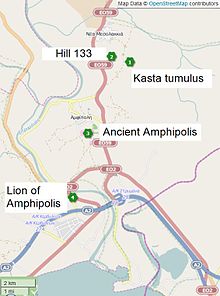 Amphipolis sites | |
| Location | Macedonia,Greece |
|---|---|
| Coordinates | 40°49′6″N23°50′24″E/ 40.81833°N 23.84000°E |
| Type | Settlement |

Amphipolis(Greek:Αμφίπολη,romanized:Amfipoli;Ancient Greek:Ἀμφίπολις,romanized:Amphipolis)[1]was an importantancient Greekpolis (city),and later a Roman city, whose large remains can still be seen. It gave its name to the modern municipality ofAmfipoli,in theSerres regional unitof northernGreece.[2]
Amphipolis was originally acolonyofancient Atheniansand was the site of thebattlebetween theSpartansandAtheniansin 422 BC. It was later the place whereAlexander the Greatprepared for campaigns leading to his invasion of Asia in 335 BC.[3]Alexander's three finest admirals,Nearchus,AndrosthenesandLaomedon,resided in Amphipolis. After Alexander's death,[4]his wifeRoxanaand their sonAlexander IVwere imprisoned and murdered there in 311 BC.[5][4]
Excavations in and around the city have revealed important buildings, ancient walls and tombs. The finds are displayed at thearchaeological museum of Amphipolis.At the nearby vastKasta burial mound,an ancient Macedonian tomb has recently been revealed. TheLion of Amphipolismonument nearby is a popular destination for visitors.
It was located within the region ofEdonis.
History[edit]
Origins[edit]

Throughout the 5th century BC,Athenssought to consolidate its control overThrace,which was strategically important because of its raw materials (the gold and silver of thePangaion hillsand the dense forests that provided timber for naval construction), and the sea routes vital for Athens' supply of grain fromScythia. A first unsuccessful attempt at colonisation was in 497 BC by theMilesianTyrantHistiaeus.[citation needed]After the defeat of the Persians at theBattle of Marathonin 490 BC, the Athenian generalKimonmanaged to occupyEiona few km south on the coast in 476 BC, and turned it into a military base and commercial port.[6][7]The Athenians founded a first colony atEnnea-Hodoi(‘Nine Ways’) in 465 BC, but the first ten thousand colonists were massacred by theThracians.[8]A second attempt took place in 437 BC on the same site under generalHagnonwhich was successful. The city and its first impressive and elaborately built walls of 7.5 km length date from this time. The new Athenian colony became quickly of considerable size and wealth.[9]
The new settlement took the name of Amphipolis (literally, "around the city" ), a name which is the subject of much debate about itsetymology.Thucydides claims the name comes from the fact that theStrymon Riverflows "around the city" on two sides; however a note in theSuda(also given in the lexicon ofPhotius) offers a different explanation apparently given byMarsyas,son ofPeriander:that a large proportion of the population lived "around the city". However, a more probable explanation is the one given byJulius Pollux:that the name indicates the vicinity of anisthmus.
Amphipolis quickly became the main power base of the Athenians in Thrace and, consequently, a target of choice for theirSpartanadversaries. In 424 BC during the Peloponnesian War the Spartan generalBrasidascaptured Amphipolis.
Two years later in 422 BC, a new Athenian force under the generalCleonfailed once more during theBattle of Amphipolisat which both Kleon and Brasidas lost their lives. Brasidas survived long enough to hear of the defeat of the Athenians and was buried at Amphipolis with impressive pomp. From then on he was regarded as the founder of the city[10][11]and honoured with yearly games and sacrifices.
The Athenian population remained very much in the minority in the city and hence Amphipolis remained an independent city and an ally of the Athenians, rather than a colony or member of the Athens-ledDelian League.It entered a new phase of prosperity as a cosmopolitan centre.
Macedonian rule[edit]
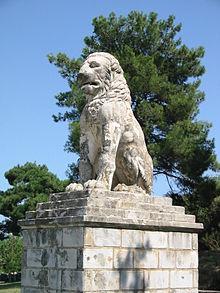
The city itself kept its independence until the reign of kingPhilip II(r. 359 – 336 BC) despite several Athenian attacks, notably because of the government ofCallistratus of Aphidnae.In 357 BC, Philip succeeded where the Athenians had failed and conquered the city, thereby removing the obstacle which Amphipolis presented to Macedonian control over Thrace. According to the historianTheopompus,this conquest came to be the object of a secret accord between Athens and Philip II, who would return the city in exchange for the fortified town ofPydna,but the Macedonian king betrayed the accord, refusing to cede Amphipolis and laying siege to Pydna as well.[12]
The city was not immediately incorporated into the Macedonian kingdom, and for some time preserved its institutions and a certain degree of autonomy. The border of Macedonia was not moved further east; however, Philip sent a number of Macedonian governors to Amphipolis, and in many respects the city was effectively "Macedonianized". Nomenclature, the calendar and the currency (thegold stater,created by Philip to capitalise on the gold reserves of the Pangaion hills, replaced the Amphipolitandrachma) were all replaced by Macedonian equivalents. In the reign ofAlexander the Great,Amphipolis was an important naval base, and the birthplace of three of the most famous Macedonian admirals:Nearchus,Androsthenes[13]andLaomedon,whose burial place is most likely marked by the famous lion of Amphipolis.
The importance of the city in this period is shown by Alexander the Great's decision that it was one of the six cities at which large luxurious temples costing 1,500talentswere built. Alexander prepared for campaigns here against Thrace in 335 BC and his army and fleet assembled near the port before the invasion of Asia. The port was also used as naval base during his campaigns in Asia. After Alexander's death, his wifeRoxanaand their young son Alexander IV were exiled byCassanderand later murdered here.[14]
Throughout Macedonian sovereignty Amphipolis was a strong fortress of great strategic and economic importance, as shown by inscriptions. Amphipolis became one of the main stops on the Macedonian royal road (as testified by a border stone found betweenPhilippiand Amphipolis giving the distance to the latter), and later on theVia Egnatia,the principalRoman roadwhich crossed the southern Balkans. Apart from the ramparts of the lower town, thegymnasiumand a set of well-preserved frescoes from a wealthy villa are the only artifacts from this period that remain visible. Though little is known of the layout of the town, modern knowledge of its institutions is in considerably better shape thanks to a rich epigraphic documentation, including a military ordinance ofPhilip Vand anephebarchiclaw from the gymnasium.[15]
Conquest by the Romans[edit]
After the final victory ofRomeover Macedonia in theBattle of Pydnain 168 BC, Amphipolis became the capital of one of the four mini-republics, ormerides,which were created by the Romans out of the kingdom of theAntigonidswhichsucceededAlexander's empire in Macedon. Thesemerideswere gradually incorporated into the Roman client state, and later province, ofThracia.According to theActs of the Apostles,the apostlesPaulandSilaspassed through Amphipolis in the early AD 50s, on theirjourneybetweenPhilippiandThessalonica;where hence they proselytized to the Greeks, includingaporeticEpicureanandStoicphilosophers.[16]
In the 1st c. BC the city was badly damaged in theThracian revoltagainst Roman rule.
Revival in Late Antiquity[edit]

During the period ofLate Antiquity,Amphipolis benefited from the increasing economic prosperity of Macedonia, as is evidenced by the large number ofChristian churchesthat were built. Significantly however, these churches were built within a restricted area of the town, sheltered by the walls of theacropolis.This has been taken as evidence that the large fortified perimeter of the ancient town was no longer defendable, and that the population of the city had considerably diminished.
Nevertheless, the number, size and quality of the churches constructed between the 5th and 6th centuries are impressive. Fourbasilicasadorned with richmosaicfloors and elaborate architectural sculptures (such as the ram-headedcolumncapitals – see picture) have been excavated, as well as a church with a hexagonal central plan which evokes that of thebasilicaofSt VitalisinRavenna.It is difficult to find reasons for such municipal extravagance in such a small town. One possible explanation provided by the historianAndré Boulangeris that an increasing ‘willingness’ on the part of the wealthy upper classes in the late Roman period to spend money on localgentrificationprojects (which he termseuergetism,from the Greek verbεὐεργετέω;meaning 'I do good') was exploited by the local church to its advantage, which led to a mass gentrification of the urban centre and of the agricultural riches of the city's territory. Amphipolis was also adioceseunder themetropolitan seeofThessalonica– the Bishop of Amphipolis is first mentioned in 533. The bishopric is today listed by theCatholic Churchas atitular see.[17]
Final decline of the city[edit]
TheSlavic invasionsof the late 6th century gradually encroached on the back-country Amphipolitan lifestyle and led to the decline of the town, during which period its inhabitants retreated to the area around the acropolis. The ramparts were maintained to a certain extent, thanks to materials plundered from the monuments of the lower city, and the large unused cisterns of the upper city were occupied by small houses and the workshops of artisans. Around the middle of the 7th century, a further reduction of the inhabited area of the city was followed by an increase in the fortification of the town, with the construction of a new rampart with pentagonal towers cutting through the middle of the remaining monuments. The acropolis, theRoman baths,and especially the episcopal basilica were crossed by this wall.
The city was probably abandoned in the eighth century, as the last bishop was attested at theSecond Council of Nicaeain 787. Its inhabitants probably moved to the neighbouring site of ancient Eion, port of Amphipolis, which had been rebuilt and refortified in theByzantine periodunder the name “Chrysopolis”.This small port continued to enjoy some prosperity, before being abandoned during theOttoman period.The last recorded sign of activity in the region of Amphipolis was the construction of a fortified tower to the north in 1367 by themegas primikeriosJohn and thestratopedarchesAlexios to protect the land that they had given to themonastery of PantokratoronMount Athos.

Archaeology[edit]
The site was discovered and described by many travellers and archaeologists during the 19th century, including E. Cousinéry (1831) (engraver),Leon Heuzey(1861), and P. Perdrizet (1894–1899). However, excavations did not truly begin until after the Second World War. TheGreek Archaeological Societyunder D. Lazaridis excavated in 1972 and 1985, uncovering a necropolis, the city wall (see photograph), the basilicas, and the acropolis. Further excavations have since uncovered the river bridge, the gymnasium, Greek and Roman villas and numerous tombs etc.
Parts of the lion monument and tombs were discovered during World War I by Bulgarian and British troops whilst digging trenches in the area. In 1934, M. Feyel, of theÉcole française d'Athènes(EfA), led anepigraphical missionto the site and uncovered further remains of the lion monument (a reconstruction was given in theBulletin de Correspondance Hellénique,a publication of the EfA which is available on line).[18]
The silver ossuary containing the cremated remains ofBrasidas[19]and a gold crown (see image) was found in a tomb in pride of place under the Agora.
The Tomb of Amphipolis[edit]

In 2012[20]Greek archaeologists unearthed a large tomb within theKasta Hill,the biggest burial mound in Greece, northeast of Amphipolis. The large size and quality of the tumulus indicates the prominence of the burials made there, and its dating and the connections of the city with Alexander the Great suggest important occupants. The perimeter wall of the tumulus is 497 m (544 yd) long, and is made of limestone covered with marble.
The tomb comprises three chambers separated by walls. There are twosphinxesjust outside the entrance to the tomb. Two of the columns supporting the roof in the first section are in the form ofCaryatids,in the 4th century BC style. The excavation revealed a pebble mosaic directly behind the Caryatids and in front of the Macedonian marble door leading to the "third" chamber. The mosaic shows the allegory of the abduction ofPersephonebyHades,but the persons depicted are Philip and Olympias of Macedon. Hades' chariot is drawn by two white horses and led to the underworld byHermes.The mosaic verifies the Macedonian character of the tomb. As the head of one of the sphinxes was found inside the tomb behind the broken door, it is clear that there were intruders, probably in antiquity.
Fragments of bones from 5 individuals were found in the cist tomb, the most complete of which is a 60+ year old woman in the deepest layer.[21]Dr.Katerina Peristeri,the archaeologist heading the excavation of the tomb, dates the tomb to the late 4th century BC, the period after the death ofAlexander the Great(323 BC). One theory is that the tomb was built for the mother of Alexander the Great, Olympias.[22]
Restoration of the tomb is due for completion in 2023[23]in the course of which building materials of the grave site which were later used by the Romans elsewhere will be rebuilt in their original location.
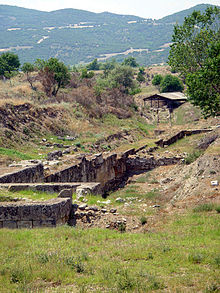
The city walls[edit]
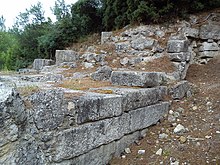
The original 7.5 km long walls are generally visible, particularly the northern section which is preserved to a height of 7.5m. 5 preserved gates can be seen and notably the gate in front of the wooden bridge.
In early Christian times another, inner, wall was built around theacropolis.
The ancient wooden bridge of Amphipolis[edit]

The ancient bridge that crossed the river Strymon was mentioned by Thucydides,[24]was strategic as it controlled access between Macedonia and theChalkidikein the west to Thrace in the east, and was important for the economy and trade. It was therefore incorporated into the city walls.
It was discovered in 1977 and is a unique find for Greek antiquity.[25]The hundreds of wooden piles have been carbon-dated and show the vast life of the bridge with some piles dating from 760 BC, and others used till about 1800 AD.
The Gymnasium[edit]
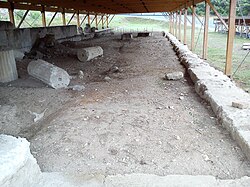
This was a major public building for the military and gymnastic training of youth as well as for their artistic and intellectual education. It was built in the 4th c. BC and includes apalaestra,the rectangular court surrounded by colonnades with adjoining rooms for many athletic functions. The coveredstoaorxystosfor indoor training in inclement weather is a long portico 75m long and 7m wide to allow 6 runners to compete simultaneously. There was also a parallel outdoor track,paradromida,for training in good weather and a system of cisterns for water supply.
During the Macedonian era it became a major institution.
The stonestelabearing the rules of the gymnasium was found in the north wing, detailing the duties and powers of the master and the education of the athletes.
After it was destroyed in the 1st c. BC in the Thracian rebellion against Roman rule, it was rebuilt inAugustus's time in the 1st c. AD along with the rest of the city.
Amphipolitans[edit]
- Demetrius of Amphipolis,student of Plato
- Zoilus(400–320 BC), grammarian, cynic philosopher
- Pamphilus (painter),head ofSicyonianschool and teacher ofApelles
- Aetion,sculptor
- Philippus of Amphipolis,historian
- Nearchus,admiral
- Erigyius,general
- Damasias of Amphipolis320 BCStadionOlympics
- Hermagoras of Amphipolis(c. 225 BC), stoic philosopher, follower ofPersaeus
- Apollodorus of Amphipolis,appointed joint military governor of Babylon and the other satrapies as far as Cilicia by Alexander the Great[26]
- Xena- In the television series Xena Warrior Princess, Amphipolis is the main character's home village.
See also[edit]
References[edit]
- ^"Amfípolis: Greece, name, administrative division, geographic coordinates and map".Geographical Names.Retrieved2014-10-22.
- ^"ΦΕΚ A 87/2010, Kallikratis reform law text"(in Greek).Government Gazette.
- ^"Amphipolis", Ministry of Culture:ISBN960-214-126-3
- ^abBadian, Ernst."Rhoxane ii Alexander's Wife".iranicaonline.org.Retrieved2022-02-14.
- ^Thirlwall, Connop(1840).A History of Greece.Longmans. pp. 318–319.
- ^Herodotus VII.107
- ^Thucydides IV.102
- ^Thucydides I, 100, 3
- ^Lazaridis D. La cité grecque d’Amphipolis et son système de défense. Comptes Rendus de l’Académie des Inscriptions et Belles Lettres. p 194–214.
- ^Koukouli-Chrysanthaki Ch., "Excavating Classical Amphipoli", In (eds) Stamatopoulou M., and M., Yeroulanou <Excavating Classical Culture>, BAR International Series 1031, 2002:57-73
- ^Agelarakis A., “Physical anthropological report on the cremated human remains of an individual retrieved from the Amphipolis agora”, In “Excavating Classical Amphipolis” by Koukouli-Chrysantkai Ch., <Excavating Classical Culture> (eds.) Stamatopoulou M., and M., Yeroulanou, BAR International Series 1031, 2002: 72-73.
- ^Theopompus, Philippica
- ^"Androsthenes Thasos - Google Search".
- ^Diodorus Siculus, Library of History Book XIX, 52
- ^Ephebarchic Law of Amphipolis- English translation
- ^Acts 17:1
- ^Annuario Pontificio 2013(Libreria Editrice Vaticana 2013ISBN978-88-209-9070-1), p. 831
- ^Bulletin de Correspondance Hellénique(in French)
- ^A. Agelarakis, “Physical anthropological report on the cremated human remains of an individual retrieved from the Amphipolis agora” in “Excvating Classical Amphipolis” by Ch. Koukouli-Chrysantkai, <Excavating Classical Culture> (eds.) Stamatopoulou M., and M., Yeroulanou, BAR International Series 1031, 2002: 72-73
- ^Andrew Marszal (7 September 2014)."Marble female figurines unearthed in vast Alexander the Great–era Greek tomb".The Daily Telegraph.Retrieved10 September2014.
- ^"Greek tomb at Amphipolis is 'important discovery'".BBC News.12 August 2014.Retrieved12 August2014.
- ^The Identity of the Occupant of the Amphipolis Tomb Beneath the Kasta Mound, Andrew Chugg, 2021, Macedonian Studies Journal, Volume II, Issue 1,https:// academia.edu/80446098/The_Identity_of_the_Occupant_of_the_Amphipolis_Tomb_Beneath_the_Kasta_Mound
- ^Pilot visits to the Kastas Mound in 2022https:// archaeology.wiki/blog/2022/03/21/pilot-visits-to-the-kastas-mound-in-2022/
- ^History of the Peloponnesian War 4.103.5
- ^Y Maniatis, D Malamidou, H Koukouli-Chryssanthaki, Y Facorellis, RADIOCARBON DATING OF THE AMPHIPOLIS BRIDGE IN NORTHERN GREECE, MAINTAINED AND FUNCTIONED FOR 2500 YEARS, RADIOCARBON, Vol 52, Nr 1, 2010, p 41–63, 2010 University of Arizona
- ^Diodorus Siculus Library of History Book XVII
External links[edit]
- Populated places in Serres (regional unit)
- Amphipolis (municipality)
- 437 BC
- 5th-century BC establishments
- 8th-century disestablishments in the Byzantine Empire
- Ancient Amphipolis
- Ancient Greek archaeological sites in Central Macedonia
- Archaeological sites in Macedonia (Greece)
- Athenian colonies
- Former populated places in Greece
- Populated places established in the 5th century BC
- Populated places disestablished in the 8th century
- Populated places in ancient Macedonia
- Populated places in ancient Thrace
- Roman towns and cities in Greece
- Populated places of the Byzantine Empire


